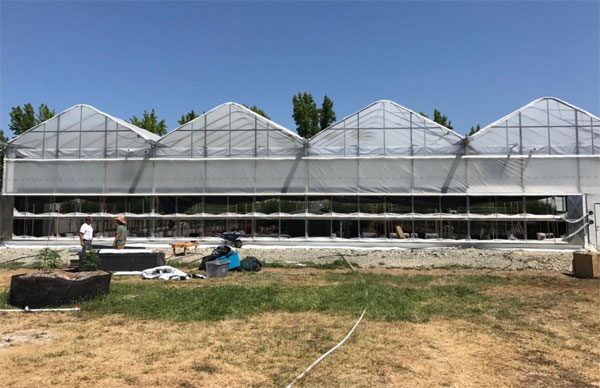How to Maintain a Greenhouse in Winter
Mar 9th 2020
For some, winter is the time to pack it up and pack it in, leaving behind notions of new growth until spring comes with its warmth and light. If you live in a cold climate with heavy snow and limited sunlight, the harsh realities of winter make it impossible to grow anything outdoors. That’s why countless growers are using the winter season to their advantage by moving their operations indoors. Greenhouse gardening in winter can turn those previously barren months into bountiful times of harvest. Here are five tips for getting the most from your greenhouse in a winter climate.
Make Your Greenhouse Winter Ready
Ironically for year round greenhouse growers, fall calls for a bit of spring cleaning. Before the last leaf has dropped from your trees, close out fall by doing some preparatory work. Spend some time winterizing your greenhouse well in advance of the winter solstice. Proper winterization will ensure your cold weather greenhouse produces the highest yields possible.
Your greenhouse is going to require some maintenance and upkeep to get it into tip-top shape before snow starts falling. A year round greenhouse in cold climates needs to be tightened up and sealed shut, keeping cold drafts out and warm air in. Not only will this give your seedlings the best chance of survival and therefore, better outcomes at harvest time, it will also reduce your energy expenses.
Common steps to take to get your greenhouse winter-ready include:
- Inspect all moving parts, including doors and make repairs or replacements as needed.
- Remove and replace any torn or worn poly sheets.
- Completely remove all organic material leftover from your fall harvest.
- Clean and disinfect walls, equipment, and tools to remove pests and debris.
- Line walls and floors with chosen light deprivation, filtering, or reflecting material.
- Look for gaps and cracks along walls or joints and seal with caulk or foam sealant.
- Consider adding homemade insulation from bubble wrap.
Make Adjustments to Account for Reduced Daylight Hours
You will have to make lighting adjustments when setting up your greenhouse for winter growing. Total daylight hours are reduced in winter. The sun rises late and goes down early. During higher sun and longer daylight seasons, your crops may have thrived with a light filtration cover. Your greenhouse in winter may need a clear, maximum light greenhouse cover to get the most from the limited daylight.
Light deprivation covers may be worth exploring in your homemade greenhouse for winter. Light deprivation greenhouse cover has two sides: a white side to reflect light and a black side to absorb light. Harness and direct as much winter sunlight as possible by using the white side to reflect it from the walls and floors of your cold weather greenhouse back to your crops.
Control Temperature and Humidity Levels
If you have a year round greenhouse in cold climates, the temperature outside will be low enough to squash any plans of growing crops, even inside a greenhouse. If your winter greenhouse is located in a harsh winter climate it will be necessary to add a heating unit to keep the interior cozy enough to coax sprouts from the soil.
If you add heat to your year round greenhouse in the winter, you must also control humidity levels. Crop diseases love heat and humidity. Keep them from taking hold of your winter crops by properly ventilating and reducing humidity in your winter greenhouse. Simple fans help with ventilation. Install dehumidifiers that will keep moisture, and therefore damaging diseases, in check.
Choose and Harvest Crops Carefully
Even though you are planting inside, greenhouse gardening in winter requires some careful crop selection. Planting hardier, cold weather-tolerant edibles will lead to a more bountiful yield. In general, root vegetables and leafy greens grow well in a homemade greenhouse for winter. There are also a couple of other edibles that are surprisingly hardy in a winter greenhouse. Top crop choices include:
Lettuces such as romaine, butterhead, and leaf lettuce.
Other salad greens like radicchio and arugula.
Greens such as spinach, collards, mustard greens, kale, and chard.
Roots like carrot, beet, and radish.
Green onion
Cilantro
Growers tend to plant a crop and plan to harvest it at once at the end of a growing season. When using a greenhouse for winter growing, this doesn’t work as well. Growing cycles will vary from other seasons and may require several small harvests rather than one big one at the end of the season. For small farmers who sell at markets, this can be advantageous as they have something to offer customers throughout the season.
Edible gardening is not the only use for your greenhouse in a winter climate. There are many flowering and decorative plants that do well in a winter greenhouse, too. Having gorgeous blooms and fronds to care for can lift the winter blues and keep your greenhouse looking alive and well during the long, darker months. Some flowers that can thrive in a temperature-controlled greenhouse in winter include:
Iris
Calla lilies
Freesia
Daffodils
Tulips
Hyacinth
Orchids
The winter is cold, dark, and feels longer in some places than others. Winter does not have to be barren, though! Keep your thumb green in every season by using a greenhouse for winter growing.


